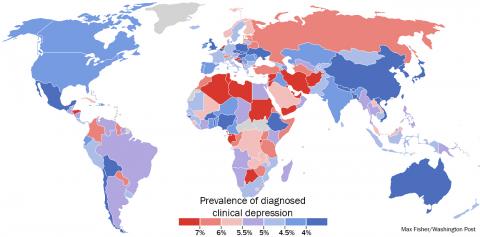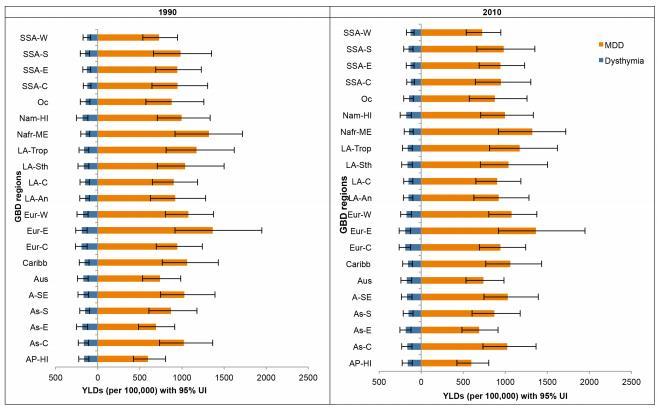A stunning map of depression rates around the world
Depression burden in regions around the world, as measured by years living with disability, in 1990 (left) and 2010 (right). The region abbreviations, from top, are sub-Saharan Africa (SSA), Oceania (Oc), North America high-income (Nam-HI), North Africa/Middle East (Nafr-ME), Latin America (LA), Europe (Eur), the Caribbean (Caribb), Australasia (Aus), Asia (A/As) and Asian Pacific high-income (AP-HI). (Ferrari et al.)
The most depressed country is Afghanistan, where more than one in five people suffer from the disorder. The least depressed is Japan, with a diagnosed rate of less than 2.5 percent.
The researchers also quantified the national “burden” of depression using a metric called DALY -- disability-adjusted life years, or the number of healthy years a person loses because of depression or a depression-related premature death. Predictably, depression burdens for the most part follow depression rates. The burden is highest in Afghanistan and in Middle Eastern and North African countries, as well as in Eritrea, Rwanda, Botswana, Gabon, Croatia, the Netherlands (!) and Honduras. It’s lowest in Asia’s most prosperous economies, including Japan.
See some patterns here? The researchers did, too. While they can’t conclusively explain why depression is so much more prevalent and damaging in some countries than in others, they have a few theories. Those include conflict, which pushes depression rates up, and the presence of other serious epidemics, which makes depression less of a social burden relative to other public health issues. Notably, Afghanistan, Honduras and the Palestinian territories are the three most-depressed areas researchers looked at.
“In the case of North Africa/Middle East, conflict in the region increased the prevalence of [depression], leading to a higher burden ranking,” they write. In sub-Saharan Africa, on the other hand, diseases such as malaria and AIDS have crowded out depression as a top public health risk. It’s still a very big deal, in other words, but HIV is responsible for far more lost-healthy-years than depression.
Social scientists and public health advocates have identified other “macro” or “environmental” causes for depression, as well. A 2010 paper by the Inter-American Development Bank found, for instance, that unemployment, low incomes and high income inequality correlate with high depression rates. They also found a link between depression and age: People between 16 and 65 tend to suffer depression at much higher rates.
That age factor, along with massive population growth, actually explains the fact that the burden of depression has grown by nearly a third since 1990, researchers say. And since both aging and population growth are likely to continue, that makes low-cost depression interventions even more of a priority for both global organizations and national governments. Unfortunately, between the costs of such programs and taboos against admitting mental health disorders, that type of action seems many years away.
Depression burden by age (Ferrari et al.)
Caitlin Dewey



